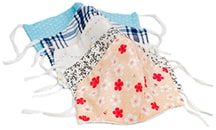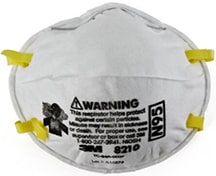When it comes to masks, there is an ever-growing variety of styles available. As we work together to stay healthy and safe during this pandemic, many of us have adjusted to wearing masks in public. The Center for Disease Control (CDC) still recommends people wear face coverings, and many state and local governments require them. Additionally, many employers have incorporated masks into safety plans. There are a variety of options to choose from. This article will help you find the right mask for you.
There are several styles and materials to choose from when searching for the right mask. Most types will prevent infected people (whether they know it or not) from spreading germs and provide some protection to the wearer. Let’s look at the most common types.
Cloth masks have become very popular, with commercial and homemade varieties readily available in stores and online. The CDC recommends wearing cloth face coverings as a protective measure in addition to social distancing. A cloth mask may reduce the amount of large respiratory droplets that spread when talking, coughing, or sneezing. They are also comfortable and breathable, making them the right mask for many people as they navigate daily life.
To be effective, cloth masks should have two or more layers of breathable fabric. You should launder cloth masks frequently, and it’s a good idea to carry a spare. If your mask becomes wet, soiled, or in any way contaminated, you should put on a different one.

In certain environments, an N95 respirator may be the right mask for you. First, let’s break down the name. The N is because they are rated for non-oily particulates, and the 95 is because they filter 95% of even the smallest airborne particulates and droplets. These respirators are designed to be tight-fitting, providing optimal protection. Of the masks we cover in this blog, this is the only type that is considered a respirator or personal protective equipment (PPE), meeting NIOSH 42 CFR 84 standards.
If your work environment does not require an N95 respirator for safety, consider using an alternative. The CDC recommends these masks be reserved for workers in medical, industrial, and construction fields where PPE is required to prevent shortages.
You should discard your N95 respirator under any of the following conditions:
- Damaged or deformed
- No longer forms an effective seal
- Wet or Dirty
- Contaminated with blood, respiratory or nasal secretions, or other bodily fluids
- Breathing difficulty

Though they don’t provide a seal, surgical masks protect your nose and mouth from larger droplets from sneezes and coughs. As their use in medical settings indicates, surgical masks can prevent infected people from spreading germs through the air. Surgical masks are designed to be disposable and are often available in large quantities. If you want to make masks available to customers and employees, this may be the right mask to provide in your reception area.
If a surgical mask becomes damaged, wet, or soiled, you should replace it immediately.

The jury is still out on neck gaiters and bandanas, and some studies have shown that they are far less effective than the options listed above. Though many people find them to be the right mask by comfort standards, the CDC lists them in the “caution” category. Before selecting these options, do some research on the latest studies and recommendations.
Without the right mask, face shields are ineffective at preventing the spread of disease. Though face shields provide eye protection against splashes from coughs and sneezes, the CDC lists them in the “caution” category when considered for mask usage. Depending on your job and need for eye protection, you may find combining a face shield with a mask provides enhanced protection. However, if you are concerned about ocular exposure, safety glasses or goggles may be a better fit.

The CDC recommends eye protection when workers may be at risk of acquiring infectious diseases via ocular exposure. Eye protection provides a barrier to infectious materials entering the eye. A study by Mayo Clinic stated, “The risk of infection among people who wore glasses, goggles, or other face shields was 6% compared to 16% among those not wearing such protection.”
- The CDC lists certain masks in the “DO NOT choose” category. These types include:
- Masks made of materials that make it hard to breathe (e.g., vinyl)
- Masks with valves or vents that allow particles to escape
If you aren’t wearing a mask properly, it’s not the right mask, and it won’t protect you or others around you. Any mask you choose should:
- Cover your nose and mouth
- Secure under your chin
- Fit snuggly against the side of your face
Additionally, you should wash your hands before and after wearing your mask and avoid touching it during wear.
The right mask cannot protect you if you aren’t wearing it properly. Here’s a list of how not to wear your mask:
- Around your neck
- On your forehead
- Under your nose
- Only on your nose
- On your chin
Our Safety Specialist, Qualified Safety Sales Professionals (QSSP), and OSHA-Certified Trainers are on hand to help you navigate pandemic safety. Contact us today!